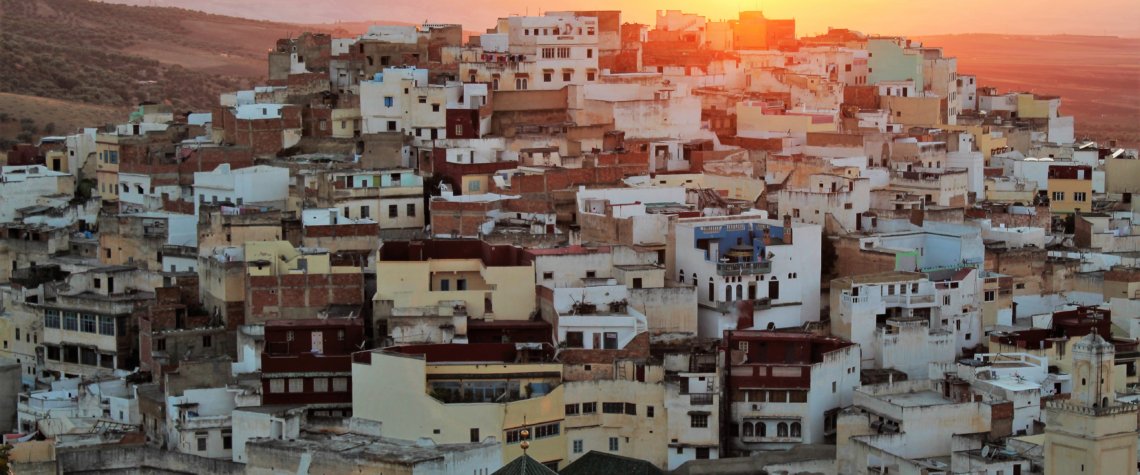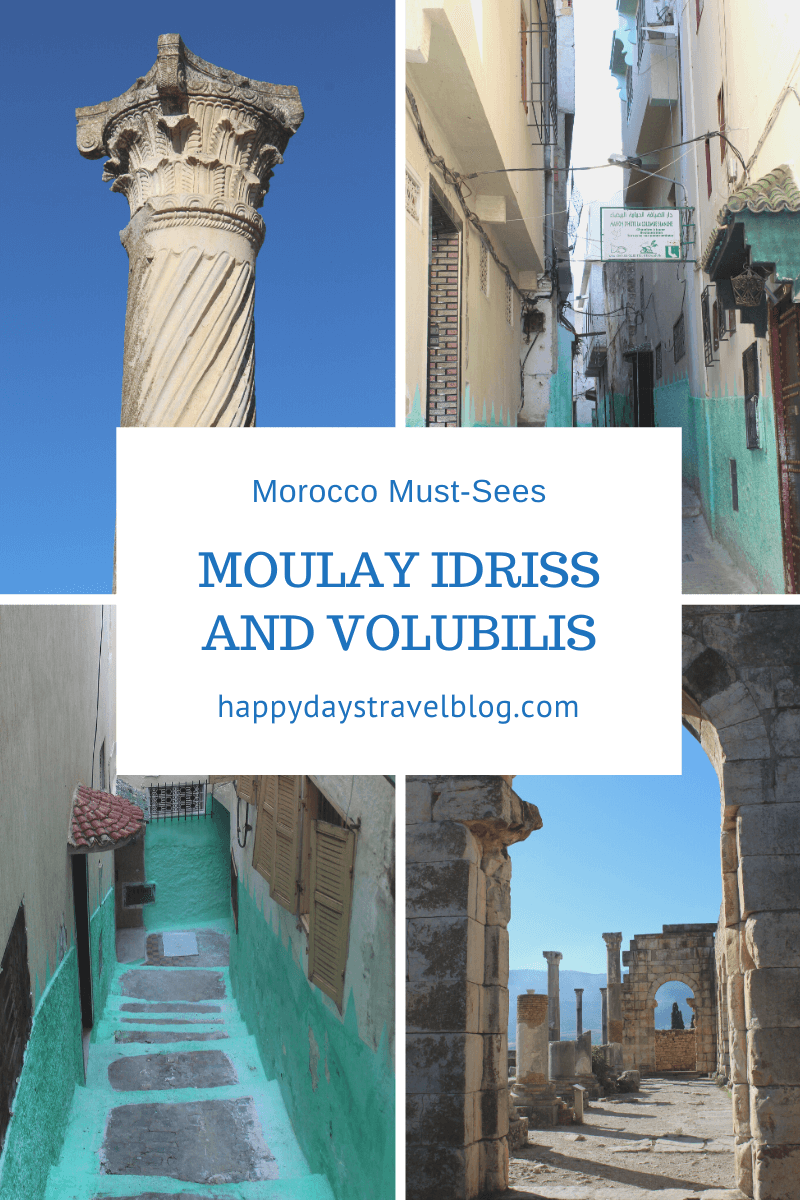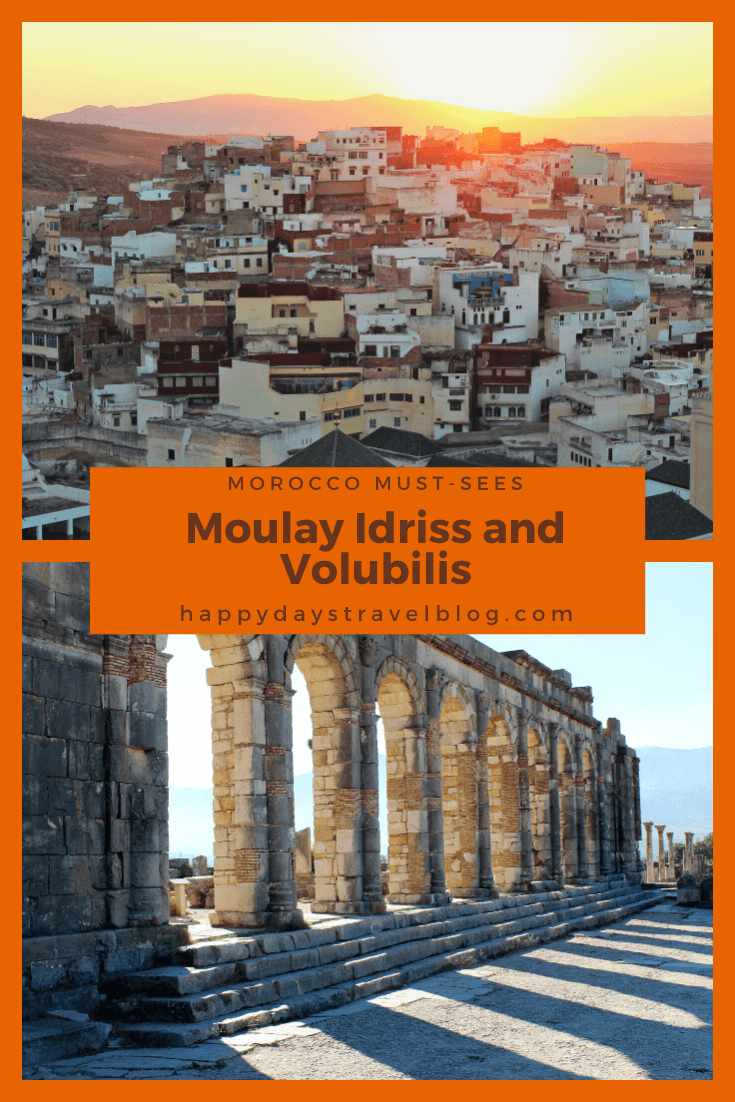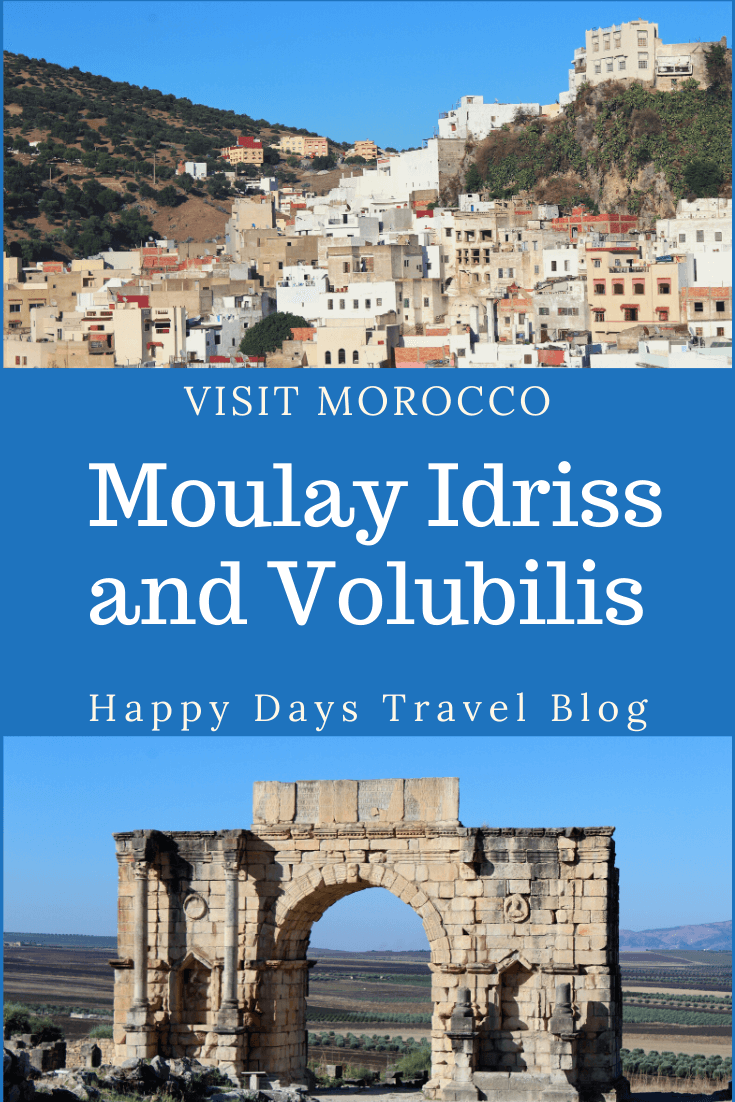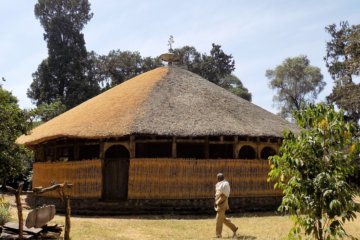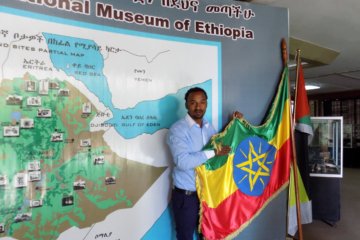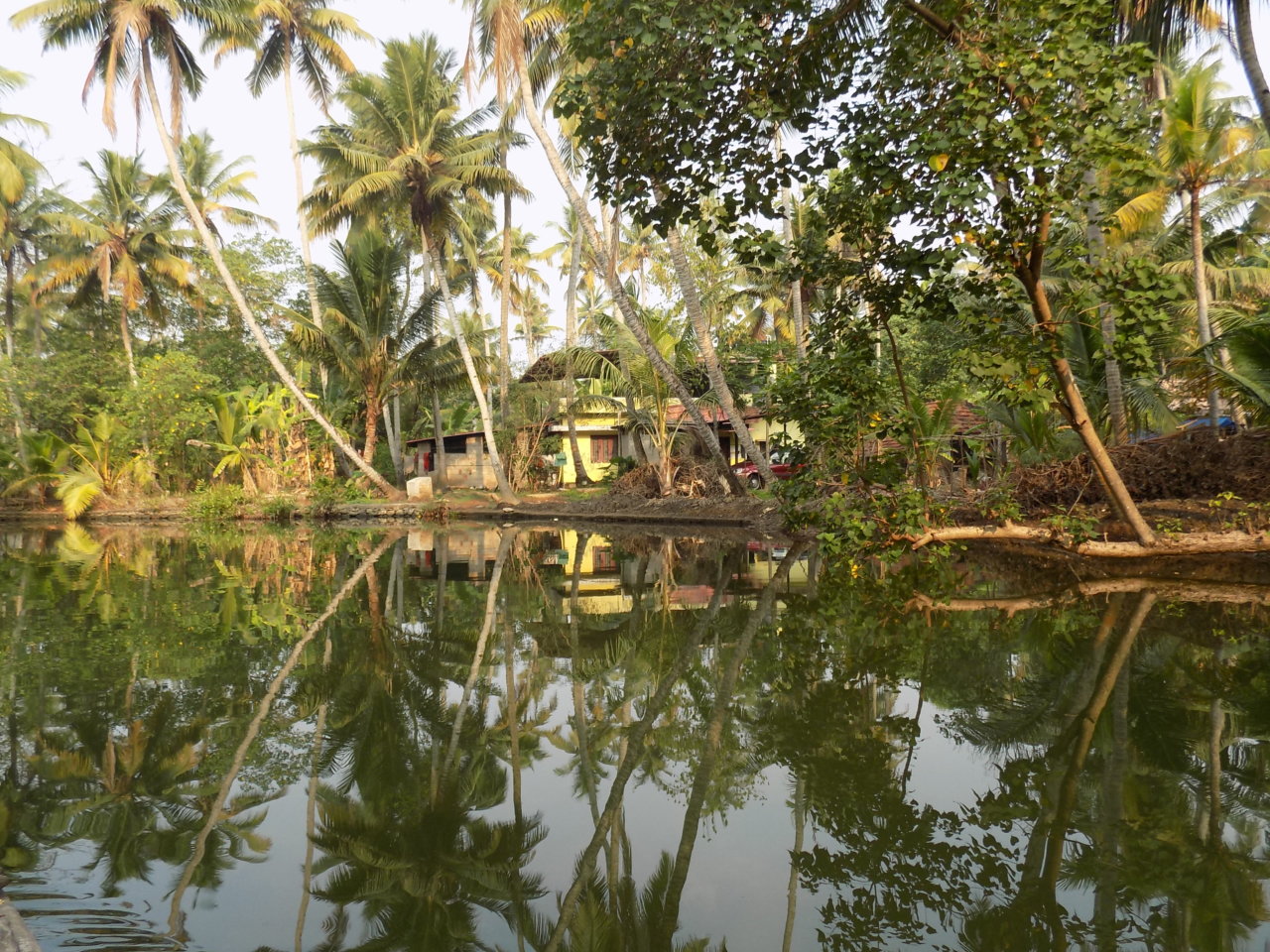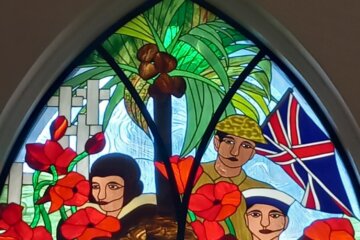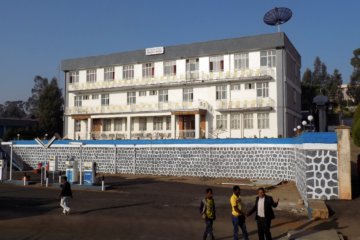If time allows, every Morocco itinerary should include Moulay Idriss and Volubilis. Few tourists make it to these spots, meaning that you’ll probably have the places pretty much to yourself. Take the opportunity to experience the real Morocco.
Fortunately for us, both Moulay Idriss and Volubilis were included on our Intrepid tour of Morocco.
The whitewashed holy town of Moulay Idriss is situated just five kilometres from the Roman ruins at Volubilis, making it the perfect place to spend the night before exploring the historic site.
In this article
Moulay Idriss
Introduction to the Town
We took the train from Rabat to Meknes and then made the 45-minute journey to Moulay Idriss by taxi. Most visitors to the town arrive this way.
It’s not possible for motorised vehicles to pass through the steep narrow streets of the hillside town, so visitors are dropped off at the bottom of the hill. Their luggage is transferred to donkeys and mules who transport it up the slopes and steps to their accommodation. Tourists follow on foot, marvelling at the green and white architecture and the stunning surroundings.
How Moulay Idriss got its Name
The town is named after Moulay Idriss who ruled from 788 to 791. He was the great-great-great-grandson of the Prophet Mohammed and is regarded as the founder of the nation of Morocco. He was the country’s first Islamic leader and is now its most revered saint.
Our Visit to Moulay Idriss
Moulay Idriss is one of Morocco’s most important pilgrimage sites. Its holy status meant it was closed to non-Muslims completely until 1912. It wasn’t until 2005 that non-Muslims were allowed to stay in the town overnight. Even now, few do. So, once the day-trippers have left, you really do feel that you are privileged to be there. It’s a very special place.
We arrived in Moulay Idriss at about 4pm. Once our bags were taken by donkeys, we had a steep five-minute walk up to our guest house.
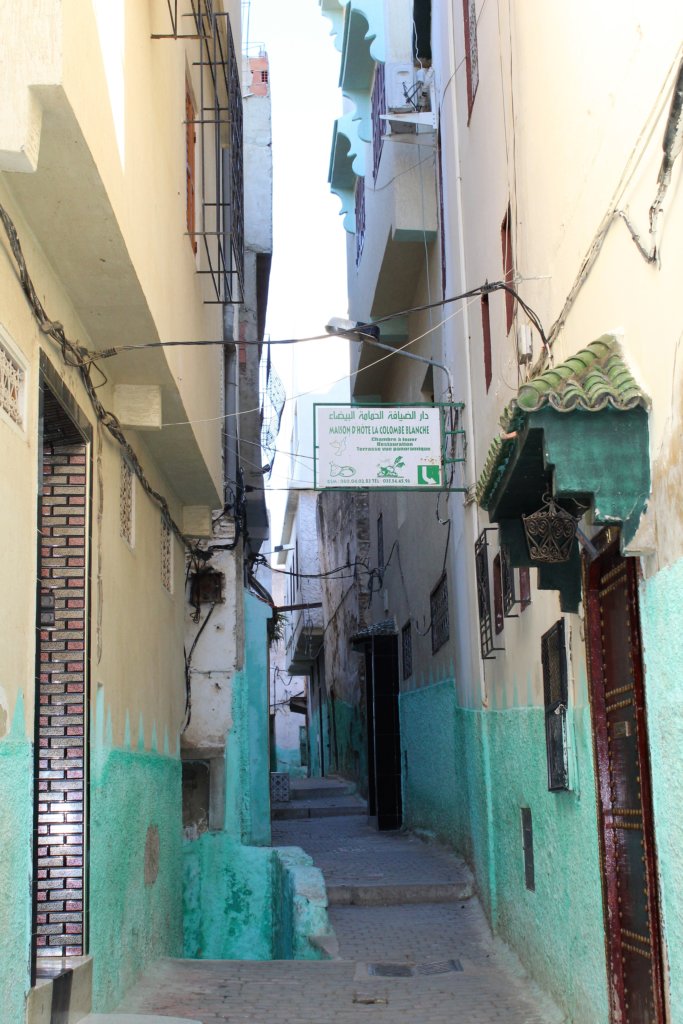
Maison d’Hôte La Colombe Blanche
As is the Intrepid way, our accommodation was locally owned. Originally, it was just a restaurant where Intrepid groups would stop for a meal before going on to a hotel somewhere else. Over the years, the family, with Intrepid’s help, have extended and they now have a number of comfortable ensuite rooms.
La Colombe Blanche is built in the Berber style around an interior courtyard. It is beautifully decorated with ornate tiles and soft furnishings covered in intricate designs.
We were greeted by the owner, Mohammed and his wife Rashida. They served us refreshing mint tea as we relaxed on deep cushions. After tea, we were shown to our rooms and had time to explore the property. There are several terraces and an open rooftop with incredible views of the town and the surrounding countryside.
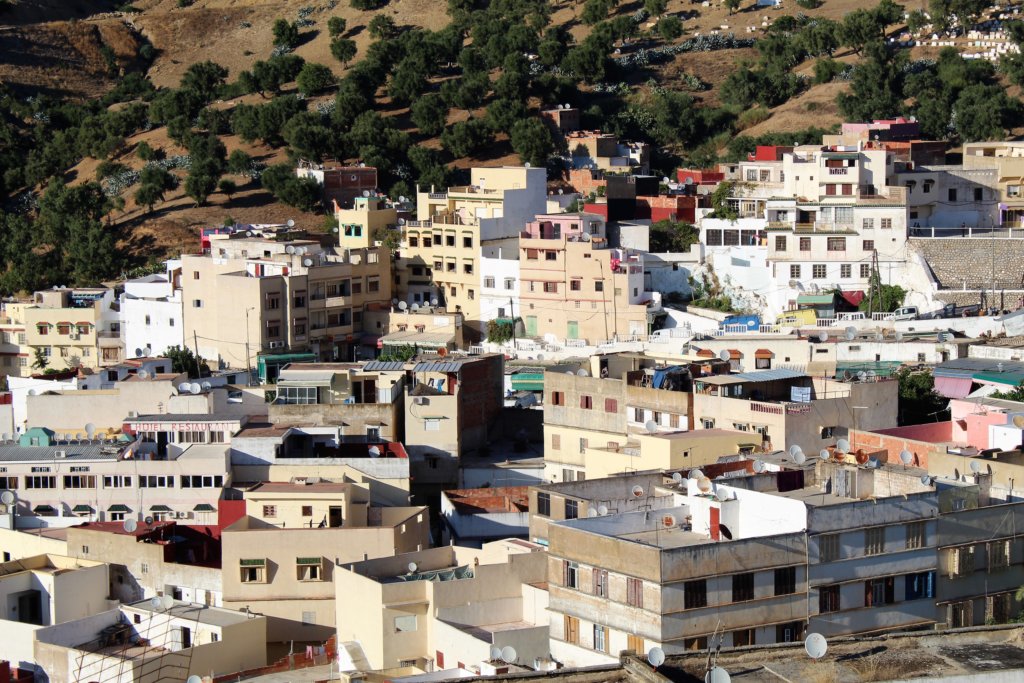
Following a walk into town, Rashida invited us all into her tiny kitchen to teach us how to make couscous properly. There’s far more to it than simply pouring on boiling water and leaving it to stand for five minutes! Learn how by watching this video:
We ate the finished couscous as an accompaniment to our dinner of olives, ratatouille and bread to start with followed by home-made soup, vegetables, meatballs in tomato sauce with omelette, and roast spiced chicken. The meal ended with fresh melon slices and grapes. It was all absolutely delicious – a real feast!
Guided Walk of Moulay Idriss
We took a guided walk of the town at sunset. I would recommend going with a guide as you will learn so much about the fascinating history of the town. You will also get to see into hidden corners which you would surely miss if you were alone. Make sure you have sturdy footwear. There are hundreds of steps and many of the ‘road’ surfaces are very uneven.
During our walk, we saw the Mausoleum of Moulay Idriss, Morocco’s most important pilgrimage site. Every August, thousands of pilgrims flood the town to pay their respects. It is said that five pilgrimages to Moulay Idriss equal one haj to Mecca. Non-Muslims are not allowed past the main gate, but it’s worth a peek through.
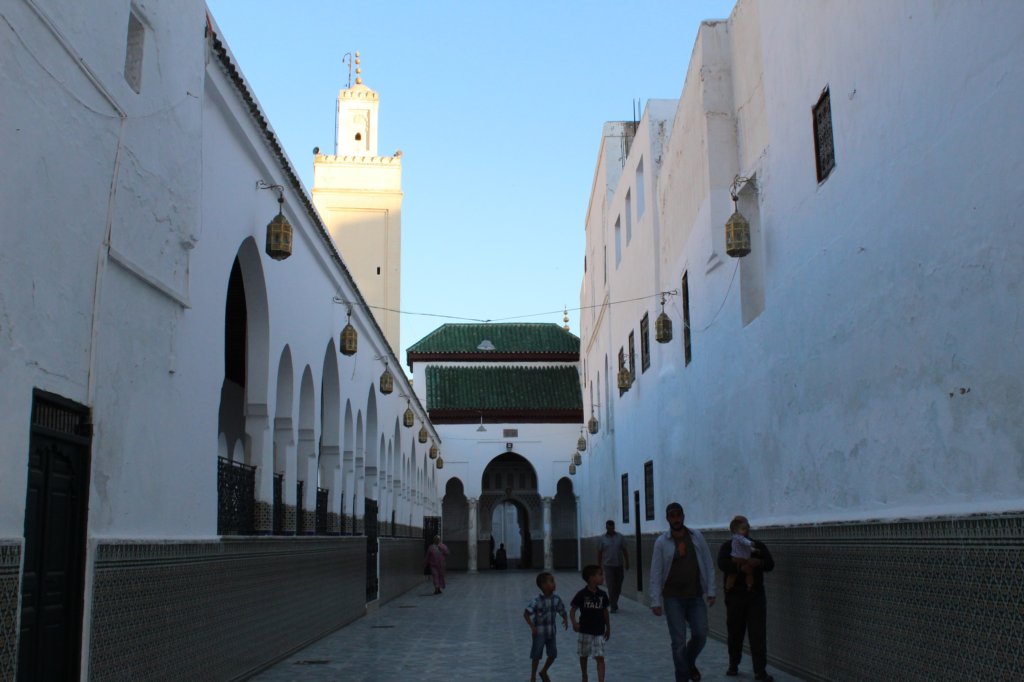
Our guide also took us to the public oven to taste delicious freshly-baked bread.
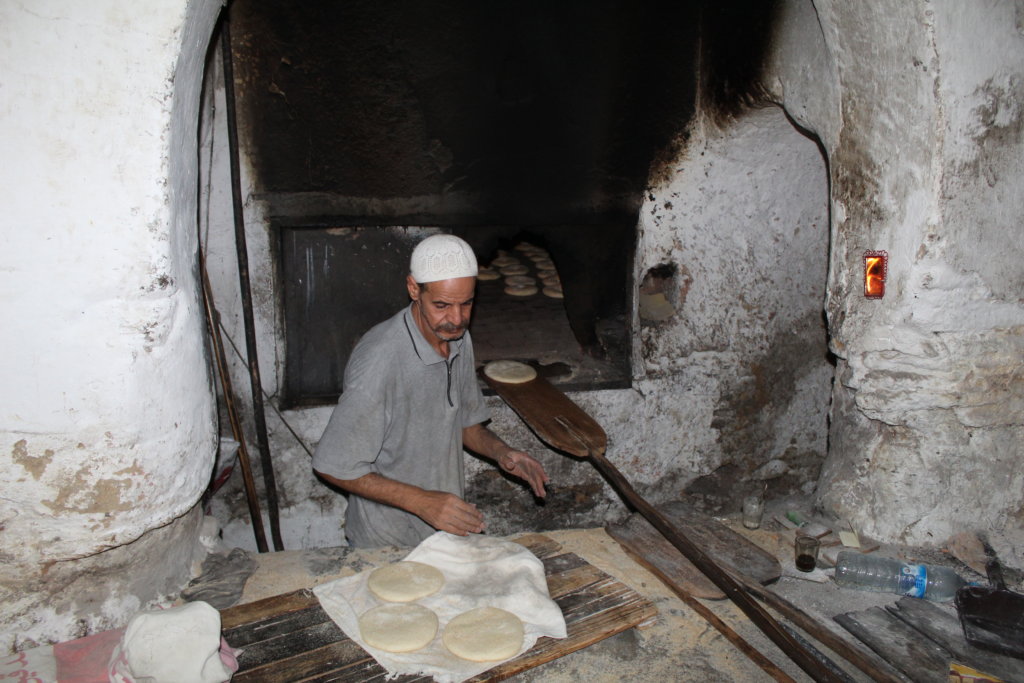
There are terraces throughout the town where you get the best views of Moulay Idriss and the green-roofed mausoleum. It would be nigh on impossible to find these vantage points on your own. You would surely get lost in the maze of narrow alleyways. Not only did our guide lead us there, but he also made sure we arrived in time to see the sun setting and hear the call to prayer being sung from the minarets of the town’s three mosques at the same time. It was a very special moment.
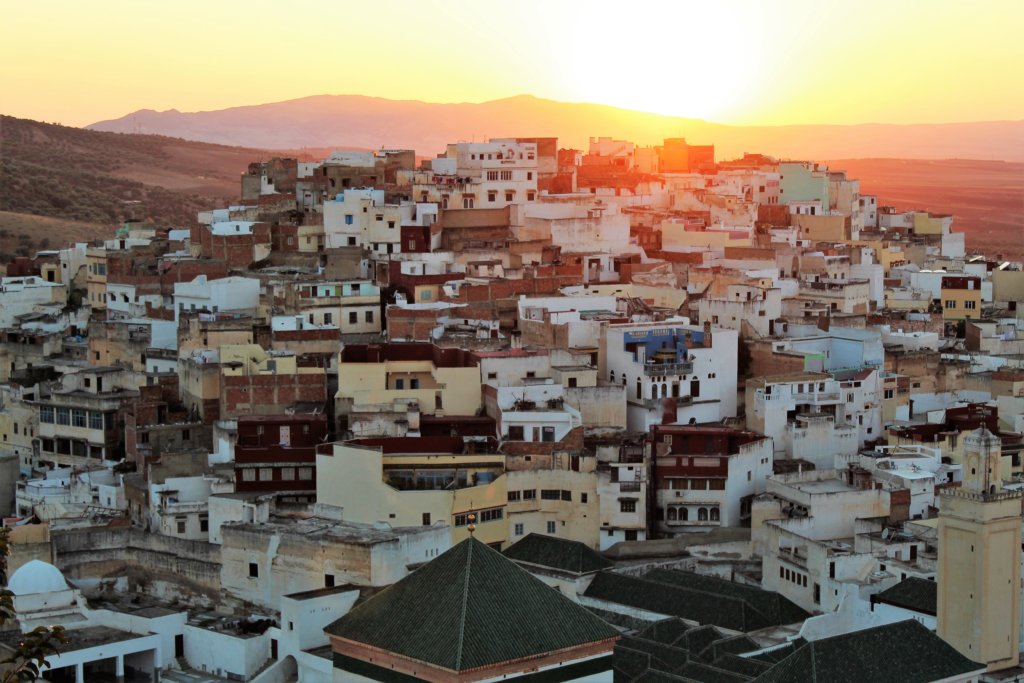
Breakfast
We were up early. It was hard to sleep through the 4am sunrise call to prayer! It was a lovely way to wake up, though, and the morning light was fantastic for the photographers amongst us!
Mohammed and Rashida surpassed themselves at breakfast. We had delicious home-made crispy pancakes served with apricot conserve and local honey followed by eggs with freshly-baked bread, olives and olive oil. There was a choice of mint tea or good strong coffee. It was the perfect start to a long day of sightseeing!
Volubilis
After breakfast, we walked down the hill to catch taxis to take us on the five-minute drive to the Roman site of Volubilis. Not as well-known as places such as Ephesus or Troy, Volubilis is no less impressive and is definitely worth a visit. It is the best-preserved archaeological site in Morocco and was declared a Unesco World Heritage Site in 1997.
History of Volubilis
Volubilis was originally settled by Carthaginian traders in the third century BC. It was annexed by the Romans in about 40AD and became one of their empire’s most remote outposts.
Rome imposed strict controls on what could be produced in its North African possessions, according to the needs of the empire. As a result, huge swathes of land around Volubilis were cleared of trees and planted with wheat instead.
At one time, 20,000 people lived in Volubilis. The site’s most impressive monuments – the triumphal arch, capitol, baths and basilica – were all built in the second and third centuries.
The Romans abandoned Volubilis in about 280AD but the city’s population of Berbers, Greeks, Jews and Syrians continued to speak Latin until Moulay Idriss brought Islam to the area in the eighth century.
Volubilis and its Roman buildings were continuously inhabited until the eighteenth century. They were finally destroyed by the Lisbon earthquake in 1755.
Our Visit to Volubilis
It is worth getting a guide to show you around Volubilis as it would be all too easy to miss things. Local guides can be hired at the entrance for around Dh200 for an hour’s tour.
The site is totally exposed and can get extremely hot in the midday sun, so try to visit early or late in the day. Take plenty of water with you. Wear a sunhat and sensible shoes – the ground is very uneven.
Volubilis has only been excavated relatively recently. Large parts of the site are still to be uncovered, including the forum and the agora. What there is to see, though, is certainly impressive.
Most of the city’s artefacts remain where they were found, but there is a new visitor centre and museum just inside the entrance to the site. There are explanations about Volubilis in French and Arabic and there are plans to house the more fragile finds here.
We were struck by the beautiful floor mosaics which have been preserved in situ in grand houses which were once clearly owned by rich Romans. We could see ornate indoor fish ponds and hot tubs.
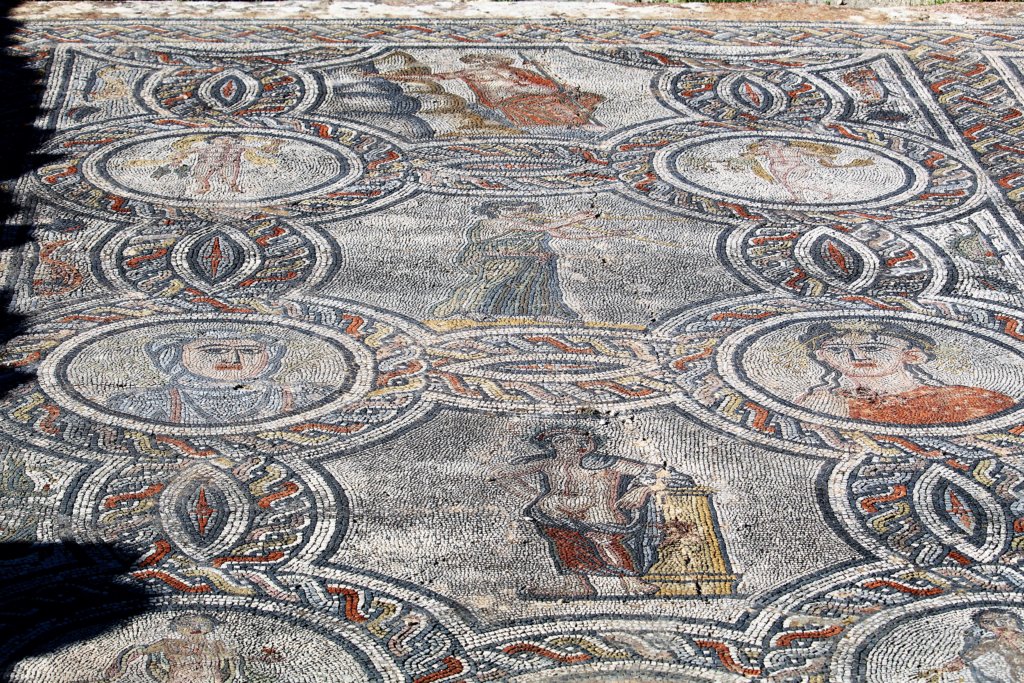
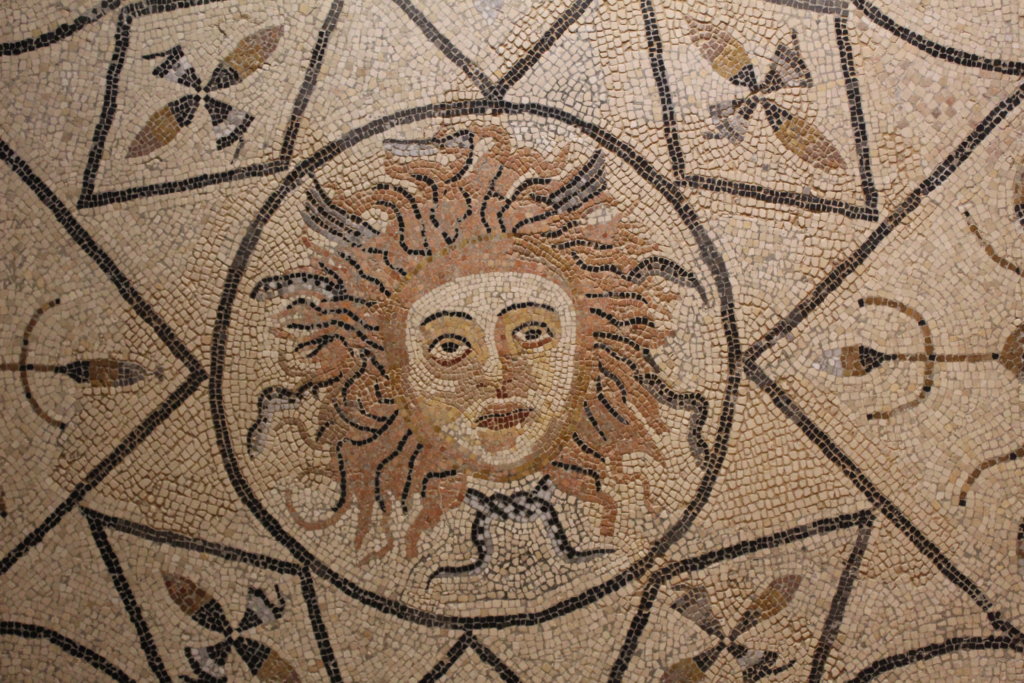
Our guide delighted in explaining the vomitorium to us! This is where the Romans would purge themselves after over-indulging in too much wine and rich food. They would do this as a communal activity! The theory is borne out by examinations of excavated skeletons. These showed that people invariably had rotten teeth with no enamel remaining, indicative of persistent vomiting!
Other highlights of our visit included the reconstructed columns of the Basilica and the marble Triumphal Arch which was built in 217 in honour of Emperor Caracalla and his mother, Julia Domna.
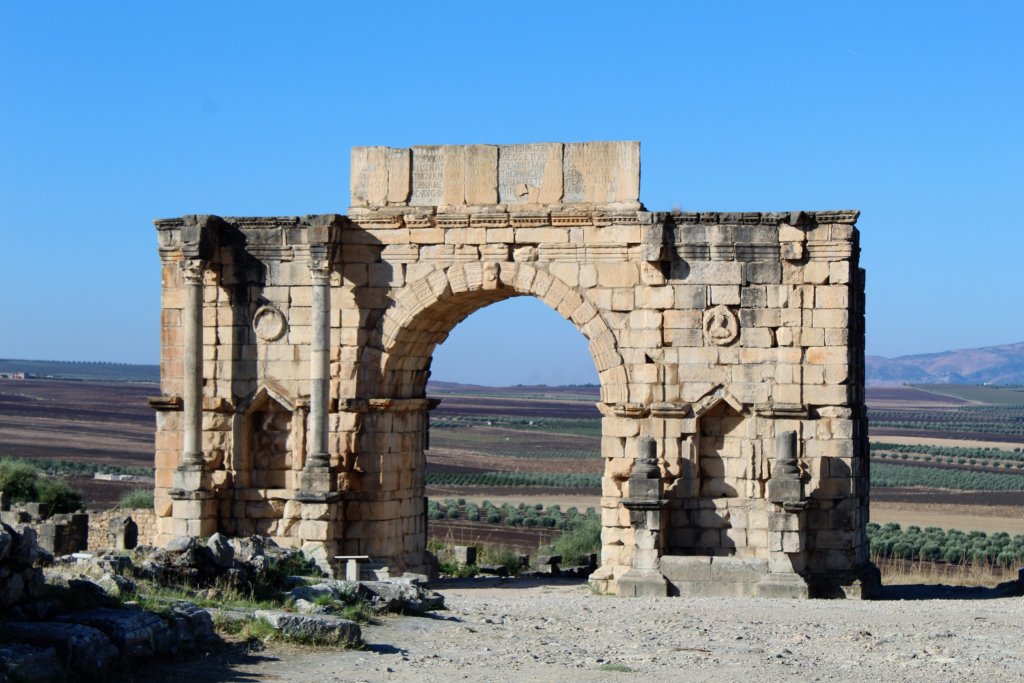
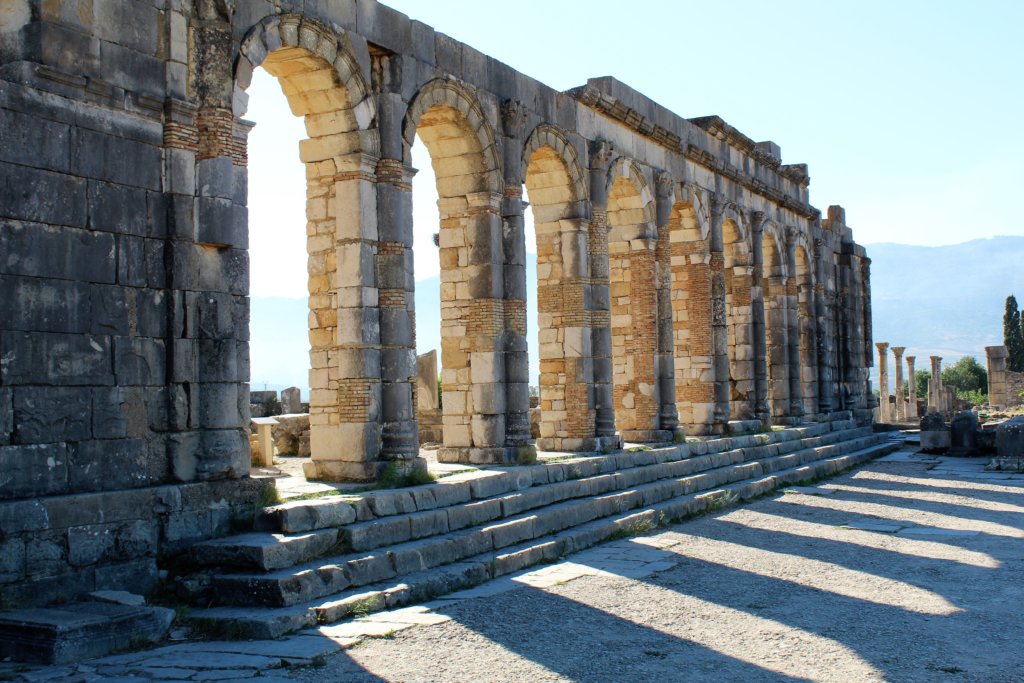
READ MY COMPLETE MOROCCO TRAVEL GUIDE
Further Reading About Morocco
Check out my Morocco colouring books!
Unlike most colouring books on the market, mine, suitable for both adults and older children, are full of line images created from photos I have taken on my travels. This means that they are highly detailed. They are not line drawings where you can colour between every line. The pictures invite you to be creative. Apply a colour wash with watercolour. Use coloured pencils to create texture. Blend colours together. Add detail with a fine ink pen. The choice is yours! Create your own work of art! When you’re happy, remove it from the book. Stick it on the fridge as a reminder of a place you’ve already been to or somewhere that’s on your bucket list. You could even get it framed. Display it on the wall for people to admire.
Here is a selection of my Morocco titles:
If you like what you’ve read, please PIN IT!!
If you’re travelling soon, please use these links!
Are you travelling soon? Use these links when making your bookings. These are the companies we use. It won’t cost you any extra, but we will earn a few pennies to help keep Happy Days Travel Blog going. Thank you!!
- Book your travel insurance with World Nomads (Never leave home without protecting yourself, your trip and your belongings!)
- Book your flight with Skyscanner
- Book your accommodation with Booking.com
- Book a tour with Tour Radar or Intrepid Travel
- Book city tours and activities with Get Your Guide
Disclosure: This post contains affiliate links. If you click through for more information, or to make a purchase, it may result in a small commission coming my way. Please note that there is no extra cost to you associated with this. Thank you so much for supporting my site.
Join our mailing list

Sign up to receive our monthly newsletter. Keep up with what we're doing and be the first to receive special offers and insider tips.

